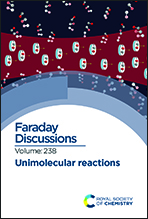Improved microcanonical instanton theory
Abstract
Canonical (thermal) instanton theory is now routinely applicable to complex gas-phase reactions and allows for the accurate description of tunnelling in highly non-separable systems. Microcanonical instanton theory is by contrast far less well established. Here, we demonstrate that the best established microcanonical theory [S. Chapman, B. C. Garrett and W. H. Miller, J. Chem. Phys., 1975, 63, 2710–2716], fails to accurately describe the deep-tunnelling regime for systems where the frequencies of the orthogonal modes change rapidly along the instanton path. By taking a first principles approach to the derivation of microcanonical instanton theory, we obtain an improved method, which accurately recovers the thermal instanton rate when integrated over energy. The resulting theory also correctly recovers the separable limit and can be thought of as an instanton generalisation of Rice–Ramsperger–Kassel–Marcus (RRKM) theory. When combined with the density-of-states approach [W. Fang, P. Winter and J. O. Richardson, J. Chem. Theory Comput., 2021, 17, 40–55], this new method can be straightforwardly applied to real molecular systems.

- This article is part of the themed collection: Unimolecular reactions


 Please wait while we load your content...
Please wait while we load your content...